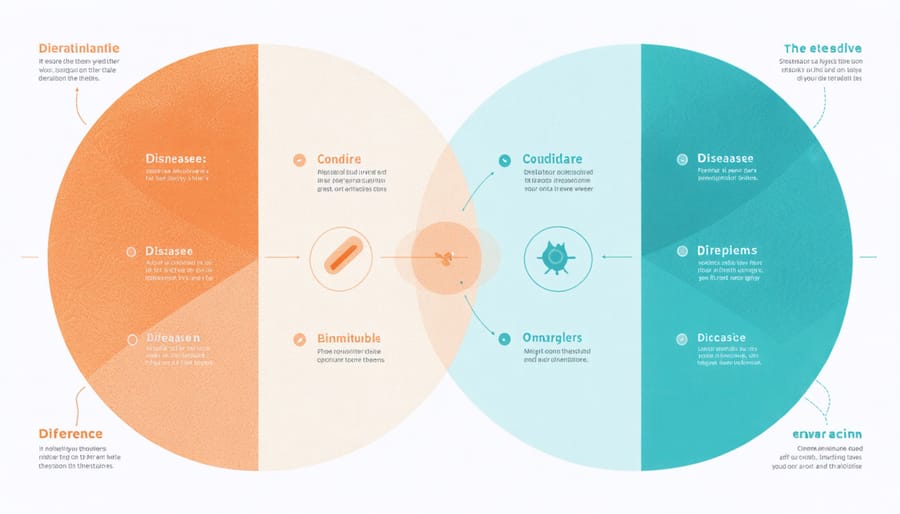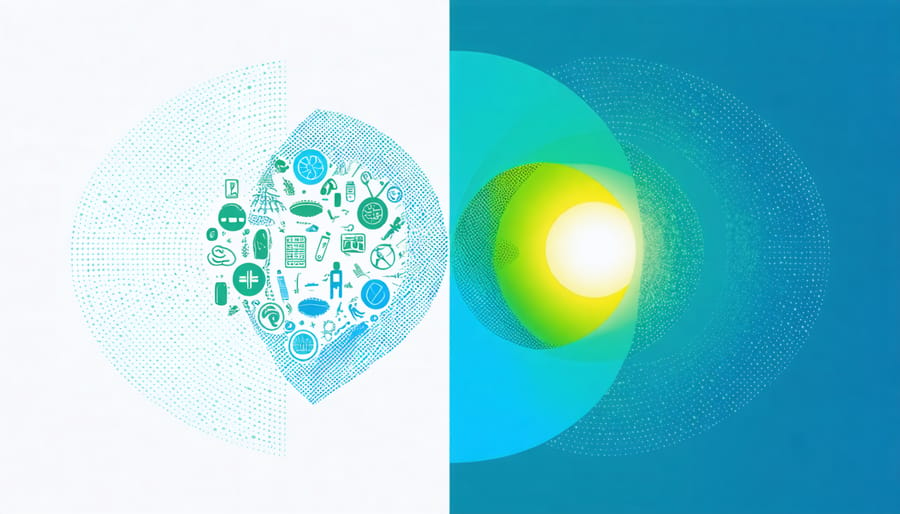Understanding the difference between medical conditions and diseases empowers you to take control of your health journey and communicate more effectively with healthcare providers. While these terms are often used interchangeably, they represent distinct concepts in modern medicine. A disease typically follows a specific pattern with identifiable causes, symptoms, and outcomes – like diabetes or pneumonia. Medical conditions, however, encompass a broader spectrum of health alterations, including temporary states, chronic situations, and even positive states like pregnancy.
This distinction matters because it directly impacts how healthcare professionals approach diagnosis, treatment planning, and long-term management strategies. For Canadians navigating the healthcare system, recognizing whether you’re dealing with a disease or a medical condition can help you better understand your treatment options, insurance coverage, and potential outcomes. As we explore these differences, you’ll gain practical insights into how this knowledge can lead to more informed healthcare decisions and improved communication with your medical team.
What Defines a Medical Condition?
Key Characteristics of Medical Conditions
Medical conditions encompass a broad range of health-related states that can affect a person’s physical or mental well-being. Unlike diseases, conditions may be temporary or long-lasting, and they don’t always follow a specific pattern of symptoms. Some conditions might develop into what’s known as a medical syndrome when multiple symptoms occur together.
Key characteristics of medical conditions include:
– Variable duration, from short-term to lifelong
– May or may not have a clear underlying cause
– Can be influenced by lifestyle factors and environment
– Often manageable through lifestyle changes or treatment
– May exist without causing significant harm or impairment
– Can be present from birth or develop over time
– Might resolve on their own without medical intervention
Medical conditions can range from common situations like pregnancy or menopause to more complex states such as chronic fatigue or anxiety. They may also include temporary states like sprains, muscle strains, or seasonal allergies. Understanding these characteristics helps healthcare providers determine appropriate management strategies and treatment plans for their patients.
Common Examples of Medical Conditions
Medical conditions encompass a wide range of health situations that Canadians encounter in their daily lives. Common examples include pregnancy, which is a natural biological state that requires medical attention but isn’t a disease. Similarly, nearsightedness and farsightedness are medical conditions that affect vision but aren’t considered diseases.
Mental health conditions like anxiety and stress also qualify as medical conditions, as they can significantly impact daily functioning while not necessarily being diseases. Physical conditions such as mild scoliosis, flat feet, or being double-jointed are other examples that demonstrate how medical conditions can be present without indicating illness or disease.
Age-related changes, such as presbyopia (difficulty focusing on close objects as we age) or reduced joint flexibility, represent another category of medical conditions that occur naturally. Temporary states like morning sickness during pregnancy or occasional insomnia also fall under medical conditions rather than diseases.
Understanding these examples helps clarify that medical conditions can range from temporary to permanent, from mild to severe, and may or may not require ongoing medical attention. Some conditions, like allergies or asthma, may increase the risk of developing related diseases but are themselves considered medical conditions.

How Diseases Differ from Medical Conditions
Defining Characteristics of Diseases
Healthcare professionals use specific criteria to identify and classify diseases, setting them apart from general medical conditions. A disease typically demonstrates consistent patterns of symptoms, identifiable causes or mechanisms, and predictable progression in the body. Medical experts look for three key elements when classifying a condition as a disease: a clear set of signs and symptoms that can be observed and measured, a known or discoverable biological mechanism that explains these symptoms, and evidence that the condition follows a typical course or pattern.
For a diagnosis to qualify as a disease, doctors also consider whether it causes significant disruption to normal body functions and if it can be confirmed through objective medical testing, such as blood work, imaging, or tissue analysis. Additionally, the condition should be recognized by the broader medical community and documented in medical literature, with established diagnostic criteria and treatment protocols.
This systematic approach to disease classification helps healthcare providers deliver consistent care and ensures that patients receive appropriate treatment based on well-researched medical evidence rather than subjective observations.
Disease Examples and Classifications
Diseases are typically categorized into several main classifications, helping healthcare providers better understand and treat them. Infectious diseases, like influenza and COVID-19, are caused by pathogens and can spread between individuals. Chronic diseases, such as type 2 diabetes and heart disease, develop over time and often require ongoing management. Genetic diseases, like cystic fibrosis, are inherited through our DNA.
Medical conditions, on the other hand, encompass a broader range of health issues. For example, pregnancy is a medical condition but not a disease, as is nearsightedness or having a broken bone. Some conditions, like high blood pressure, can be both a medical condition and a risk factor for disease.
It’s worth noting that some re-emerging diseases like tuberculosis and measles have made comebacks in recent years, highlighting the importance of understanding these classifications. Mental health challenges present an interesting case, as they can be classified as both medical conditions and diseases, depending on their nature and severity. For instance, clinical depression is considered a disease, while temporary stress might be classified as a condition.
Why the Distinction Matters for Your Health
Impact on Treatment Approaches
The classification of a health issue as either a medical condition or disease significantly influences how healthcare providers approach treatment plans. When dealing with diseases, especially infectious diseases, treatment typically follows standardized protocols and evidence-based guidelines. These often involve specific medications, procedures, or interventions aimed at curing or managing the disease.
In contrast, medical conditions often require more individualized treatment approaches. Healthcare providers may focus on symptom management, lifestyle modifications, and supporting overall well-being rather than pursuing a definitive cure. For example, chronic back pain might be addressed through a combination of physical therapy, exercise, stress management, and pain relief techniques, tailored to each person’s specific needs and circumstances.
Understanding this distinction helps both healthcare providers and patients set realistic expectations for treatment outcomes. While diseases often have clear treatment endpoints, medical conditions may require ongoing management and regular adjustments to care plans. This understanding also influences how healthcare teams coordinate care, with medical conditions often benefiting from a more holistic, multi-disciplinary approach.
For Canadians navigating the healthcare system, recognizing these differences can lead to better communication with healthcare providers and more active participation in treatment decisions. It helps patients understand why certain approaches are recommended and what they can expect from their treatment journey.


Insurance and Healthcare Coverage
In the Canadian healthcare system, the distinction between medical conditions and diseases can significantly impact insurance coverage and access to treatment. Under the Canada Health Act, essential medical services are covered for all eligible residents, regardless of whether they’re dealing with a disease or medical condition. However, the classification can affect how quickly you receive treatment and what additional coverage you might need.
Provincial health insurance plans typically provide comprehensive coverage for diagnosed diseases, including necessary medications during hospital stays, treatments, and follow-up care. Medical conditions, especially chronic ones, might require ongoing management that falls outside basic coverage, such as physiotherapy, counselling, or specialized equipment.
Private insurance plans often use these distinctions in their coverage policies. Some plans may offer more extensive coverage for diagnosed diseases while placing certain limitations on medical conditions, particularly pre-existing ones. This is why it’s important to understand how your insurance provider defines and covers both categories.
For workplace insurance and disability claims, the documentation of a disease versus a medical condition can influence claim approvals. Diseases, with their clear diagnostic criteria, often face fewer challenges in the claims process compared to some medical conditions that may have more subjective symptoms or varying severity levels.
Understanding these distinctions can help you better navigate both public and private healthcare coverage, ensuring you know what additional insurance you might need to supplement your provincial coverage.
Making Sense of Your Diagnosis
When you receive a medical diagnosis, understanding the terminology used by healthcare providers can feel overwhelming. Start by asking your doctor to explain your diagnosis in simple terms, and don’t hesitate to request clarification if something isn’t clear. It’s helpful to take notes during appointments or bring someone along who can help you remember important details.
Your healthcare provider may use various terms to describe your health situation. While they might use “condition” and “disease” interchangeably, understanding the distinction can help you better comprehend your diagnosis and treatment plan. If you’re diagnosed with a condition, this typically refers to any deviation from your normal health state, which may or may not develop into a disease. A disease diagnosis usually indicates a more specific set of symptoms or health issues with an identified cause or pattern.
Remember that you’re entitled to access your medical records and test results. Many Canadian healthcare facilities now offer patient portals where you can review your health information online. Use these resources to familiarize yourself with your diagnosis and prepare questions for your next appointment.
When discussing your health with different healthcare providers, maintain a list of your diagnoses, medications, and treatments. This helps ensure consistent communication across your healthcare team. Don’t be afraid to seek a second opinion if you’re unsure about your diagnosis or treatment plan – this is a common and accepted practice in Canadian healthcare.
Finally, consider joining support groups or patient communities related to your specific diagnosis. These networks can provide valuable insights and emotional support while helping you navigate your healthcare journey.
Understanding the distinction between medical conditions and diseases empowers you to better manage your health and communicate effectively with healthcare providers. While diseases are specific illnesses with identifiable causes and symptoms, medical conditions encompass a broader range of health situations that may or may not be diseases. This knowledge helps you make informed decisions about treatment options, lifestyle modifications, and preventive care.
Remember that both medical conditions and diseases require attention and proper medical care. Always consult healthcare professionals for proper diagnosis and treatment plans. By staying informed and proactive about your health, you can work more effectively with your healthcare team to achieve the best possible outcomes. Whether managing a chronic condition or addressing an acute disease, understanding these differences helps you navigate the healthcare system with confidence and take charge of your well-being.

